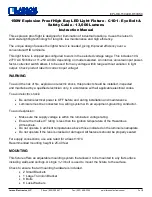
7
WARNING: The electrical power supply connection to the SMH-supplied control must be made
through a customer supplied safety disconnect switch mounted next to the control. Incorporation of an
emergency stop may also be required, per local electrical codes.
WARNING: The unit must be properly grounded and verified at installation.
The conductors between the feeder and the control must be sufficient to carry the current and voltage
indicated on the equipment nameplate. When the feeder and control are properly installed and all wiring
is complete, the feeder is ready for operation.
OPERATION
WARNING: Before operating the feeder, be sure the control cover is closed and secured.
NOTE: The BF-4-ALF/ASLF Feeder and UMC-30 Control are preset at the factory and do not require
adjustment. If a replacement Control or Printed Circuit Board is purchased, they will need to be
matched to
the feeder as specified in the control instruction manual provided with the Control.
WARNING: During normal operation, the feeder performs with a smooth, even stroke. If a loud
striking noise occurs, immediately turn off the unit and verify that the feeder drive and or trough are not
contacting any adjacent object or structure.
Striking occurs when the faces of the armature and core make contact. Striking can result in serious
damage to the unit. To correct a striking condition, refer to the Air Gap instructions on page 10.
With the feeder operating satisfactorily, load the trough with the material to be conveyed and adjust the
control knob to the desired output. The material will flow along the trough surface in a smooth, controlled
rate of feed toward the discharge end of the trough. Refer to the UMC-30 Service Manual for additional
setup procedures.
NOTE: The UMC-
30 Control must be adjusted with a “Soft Start Setting” of 1.2 seconds.
MAINTENANCE
WARNING: Disconnect the power supply at the customer supplied safety disconnect switch before
performing any maintenance work.
MAINTENANCE
(cont’d)
Some materials may adhere to the trough surfaces. If permitted to build up, these deposits increase the
weight of the feeder pan causing the feeder to operate at a reduced stroke. Material buildup on the





































